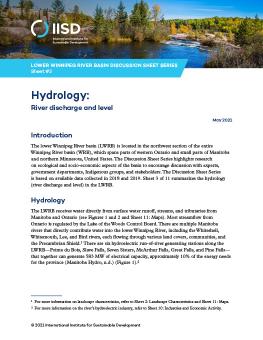
Lower Winnipeg River Basin Discussion Sheet Series Sheet #3 | Hydrology: River discharge and level
-
There are six hydroelectric runoff river-generating stations along the LWRB—Pointe du Bois, Slave Falls, Seven Sisters, McArthur Falls, Great Falls, and Pine Falls—that together can generate 583 MW of electrical capacity, approximately 10% of the energy needs for the Province of Manitoba.
-
The Winnipeg River releases the greatest volume of water to Lake Winnipeg and contributes the second-largest nutrient load.
The lower Winnipeg River basin (LWRB) is located in the northwest section of the entire Winnipeg River basin (WRB), which spans parts of western Ontario and small parts of Manitoba and northern Minnesota, United States. The Discussion Sheet Series highlights research on ecological and socio-economic aspects of the basin to encourage discussion with experts, government departments, Indigenous groups, and stakeholders. The Discussion Sheet Series is based on available data collected in 2018 and 2019. Sheet 3 of 11 summarizes the hydrology (river discharge and level) in the LWRB.
Participating experts
You might also be interested in
Dogs More Effective Than Any Other Method at Finding Oil Spills under Ice with Practical Implications for Protecting Water Supplies and Oceans: New Study
Scientists in Canada have discovered, for the first time, that dogs can sniff out certain types of oil spilled under ice in freshwater lakes, with a 100% success rate.
The Experiment of a Lifetime: IISD Experimental Lakes Area Annual Report 2023-2024
It is with great pride, excitement—and a touch of incredulity—that IISD and the Experimental Lakes Area clink our glasses to toast the end of our first decade together.
INC-4 Is an Opportunity to Address Fresh Water Pollution – This is how
INC-4 is the fourth meeting in a series of international negotiations that aims to develop a global treaty on plastic pollution that could and should have big implications for freshwater quality both in Canada and beyond.
Federal Legislative Authority in Relation to Oil and Gas Development in Canada
This report outlines federal legislative authority related to oil and gas development in Canada.